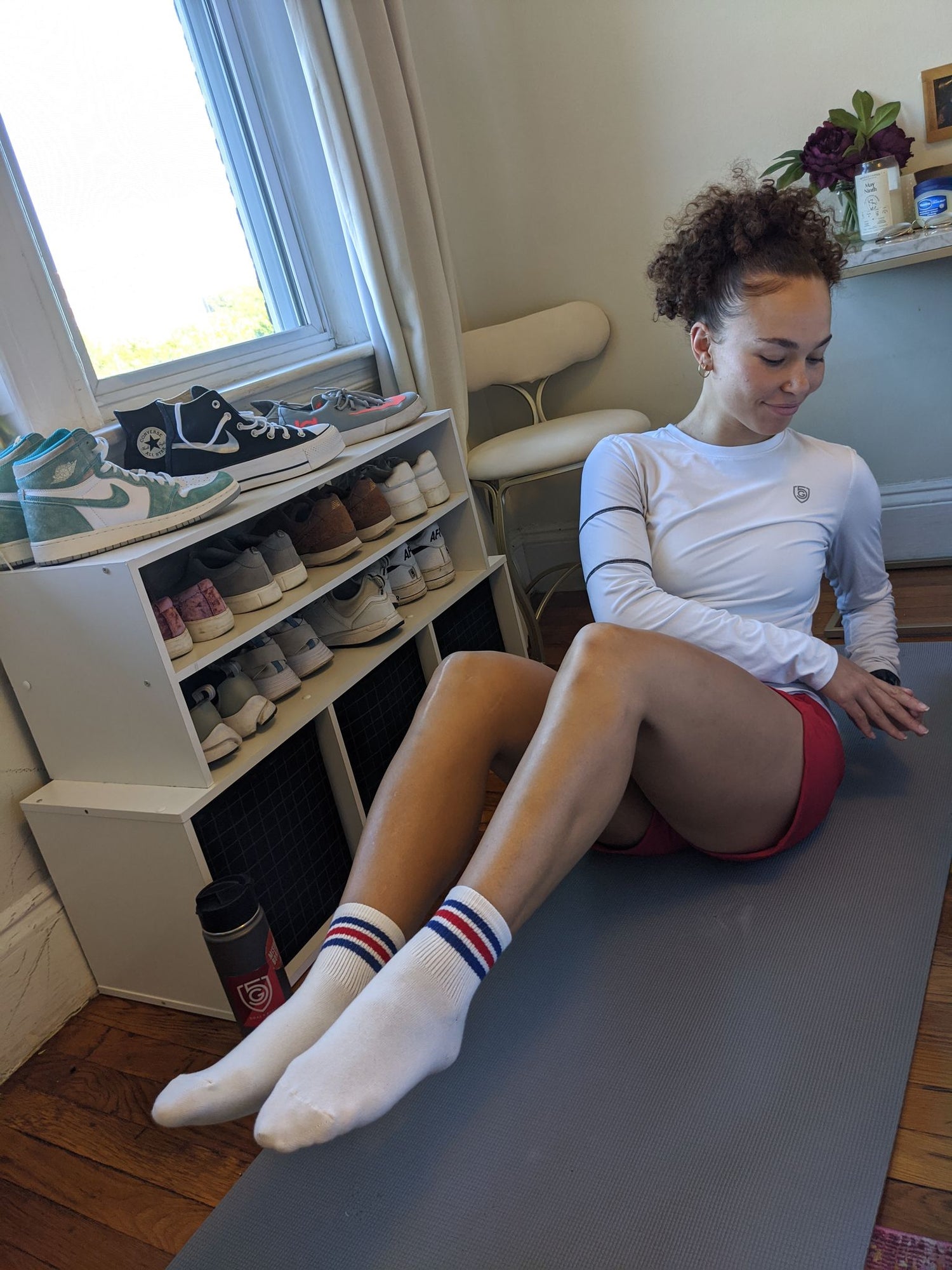How to Workout at Home (Do it Right this Time)
Did being stuck at home for too long make you rethink your gym membership?You’re wondering, “Do I really need access to tons of equipment to get a good workout in?”
Maybe you’ve worked out at home as a last resort a few times, but find it hard to be as motivated. Maybe you want to make it more of a permanent thing, but you’re not sure how to do effective exercises in-home and turn them into a real routine.
The good news: Achieving your fitness goals at home is possible and worth a try when you know the best at-home workouts for any fitness level.
15 At-Home Workout Mistakes (& What to Do Instead)
The gym has advantages like classes and schedules, familiar equipment, trainers/instructors, gym buddies, and even amenities to help post-workout recovery.
But most people can establish just as good of a fitness routine without the gym once they discover the best way to workout at home.
Take control of your fitness and avoid these 15 common pitfalls.
1. Winging it
If you’re doing whatever you feel like, whenever you feel like it, you might not reach any long-term fitness goals.
What to do instead:
Have a fitness plan. You can choose to use on an online program, get help perfecting your own from a friend or trainer, or you might be knowledgeable enough to strategize a plan for your personal fitness level. Either way, so many factors go into a fitness journey. We recommend creating or following a plan so you don’t leave out vital steps.
Planning helps you track progress, adjust pacing or strategy, and utilize everything in your toolkit to keep your eyes on the prize.
2. Getting ahead of yourself
Starting something new is exciting. It might be tempting to go from 0 to 100 too quickly, which unfortunately could cause burnout or even injury.
What to do instead:
Be honest about where you are right now to aim for incremental, realistic, sustainable improvement. Scheduling, rest, recovery, variety, finding motivation, and listening to your body and mind will help you with that steady climb.
3. Letting the scale determine progress
Many of us grew up surrounded by diet culture, which emphasizes that weight and conforming to beauty standards are the top goals of working out. Yikes.
Even if you are working out to lose weight, the scale shouldn’t be your primary focus or metric. Muscle is denser than fat, so it is possible to gain weight while improving your health.
What to do instead:
The ultimate litmus test for true fitness progress, is feeling healthier and stronger while continually working towards your own personal goals.
4. Skipping warmups
Especially on hectic days when fitting a workout in is a challenge, warming up can seem like a waste of time. When you’re developing your fitness routine and learning how to do good exercise, in-home preparation shouldn’t be forgotten.
What to do instead:
Warming up can make exercise more effective by oxygenating the body, reducing chances of injury by loosening joints and muscles, and getting your body and brain in sync. Always warm up gradually first to target the workout you’re prepping for.
If you’re dealing with a serious time crunch, cut the workout short for today instead of skipping warm-ups and risking injury.
5. Static stretching
We don’t know what you learned in your school’s gym class, but holding your foot or elbow for a minute before your workout doesn’t do much, and ballistic (bounce) stretching may be even worse.
What to do instead:
Dynamic stretching involves gentle movements that engage the body parts you’ll be using and mimic the movements you’ll be doing. Warming up your body in this this way gets your body ready to move and helps prevent injury.
6. Getting distracted
We get it — we love our smartphones. We use them for everything, including fitness tracking, music, and sharing your workout journey online. It’s become too easy to let these useful tools break our focus.
What to do instead:
If you use your phone to time yourself, follow a workout, or play music, do what you can to prevent distractions.
Keep the TV off, keep your phone out of immediate reach, and consider silencing calls or texts. Better yet, fill your social circle in on your exercise schedule and see if they want to join. Then, you can help hold each other accountable.
7. Not recovering
Life is overwhelming enough without the commitment of a fitness schedule. There are so many ways to trick ourselves into thinking we’re resting when we’re not. It’s not enough to sit down and scroll while catching your breath, just to rinse and repeat tomorrow.
What to do instead:
Real workout recovery is intentional and holistic. It ensures you’re able to bring your A-game every day without exhaustion or injury. It involves adequate rest, water intake, nutrition, stretching, and low-intensity movement. Massage, foam rollers, water therapy, and meditation can take workout recovery to the next level.
8. Inconsistency
You won’t stick with it if you can’t take a focused, measured approach. Being too spontaneous or taking many days off can make you lose momentum, bringing progress to a screeching halt.
What to do instead:
Instead of bouncing around between a plethora of different exercises, choose a system that aligns with your goals and fitness level, and follow through with it. Practice discipline, commit to your schedule, and have accountability partners.
9. Complacency
Routine is key, but things shouldn’t be too routine. Don’t revert to autopilot.
What to do instead:
Rather than repeating the same stuff every day, avoid the plateau by varying reps, weight, and intensity — enough to keep things challenging.
10. Forgetting hydration
Dehydration is no joke. It happens more easily than you think, especially when you’re losing fluid during exercise.
What to do instead:
Make sure to keep a water bottle with you, and ensure you hydrate throughout the day. Added electrolytes and potassium can help you stay hydrated and recover.
11. Not eating right
A diet with disproportionate amounts of processed carbs and sugars does nothing to provide sustained energy or help you build muscle. Plus, processed carbs and sugars typically have a low nutrition value.
What to do instead:
The cliché is true — it’s all about moderation. Don’t overthink it, but eat wholesome food with a balance of vegetables and fruits, hearty carbohydrates, protein, and fat that works for you while keeping processed, fried, and sugary foods to a minimum.
12. Lacking a good sleep schedule
We don’t do ourselves any favors when we stay up too late, sleep too much, or exercise while sleep deprived.
What to do instead:
Try to sleep and wake at a consistent time. Maximize sleep quality by keeping work, stress, snacks, caffeine, and screen time out of your bedtime routine.
13. Ignoring form
It’s a great feeling to be confident about your routine, but overconfidence or underconfidence can lead to serious mistakes in form that limit exercises’ effectiveness and increase injury risk.
What to do instead:
Stay engaged — pay attention to your body and focus on moving correctly. It takes concentration to stay grounded and perform movements in a way that actually builds strength, coordination, stability, and flexibility. Look up tutorials, ask a friend to walk you through certain steps, or use a mirror to make sure you’re getting it right.
14. Getting discouraged
We all fall short of a goal once in a while or have a bad day. On some days, it might feel useless to keep going — you’re too busy, too tired, and the list goes on.
What to do instead:
Bad days happen, but don’t let a bad day become a bad week. Have compassion for yourself. Find the motivation to jump this hurdle instead of throwing away all the progress you’ve made. Ignore the temptation to quit or skip working out. Talk to an accountability partner, adjust your goals or schedule, and make it work.
15. Wearing the wrong gear
The perfect workout gear should be balanced: Not too tight that it restricts motion but not too loose with excess material getting in the way, and not made with stuffy, uncomfortable fabric. The right gear should allow you to move freely.
What to do instead:
The right cut, style, and fit should provide the look, coverage, and comfort that uniquely suit you. A pair of breathable shorts (with pockets!), a workout tank with moisture-wicking fabric, and a comfortable, chafe-free sports bra can maximize your workout. Made with care for the female body, made with your confidence in mind, and made to breathe — your gear should contribute to a distraction-free exercise routine.
5 Home Workout Misconceptions (What's the Truth?)
The idea that at-home fitness doesn’t work is wrong, and there’s proof.
You can’t strength train at home without weights.
Aerobics and yoga are effective ways to work out at home that can give you an absolute run for your money. Bodyweight exercises have been proven to improve at least three physical function assessments while being less taxing on the joints and spine, as well as benefitting functional strength.
Working out at home doesn’t have the same motivation as the gym.
This can be true for some people, but this doesn’t have to be the case. Is the prospect of spending money on a membership enough to sustain long-term commitment? If you can’t find the long-term motivation within yourself to go for it day after day without the gym, then having a gym membership is unlikely to significantly help.
The gym always offers better workouts than you can do at home.
Not true. It’s clinically proven that just about anyone can gain muscle, reduce body fat, and improve their quality of life exercising at home. Even if you run out of ideas, there are so many online resources to help you plan, switch things up, keep it fun, and learn new workouts.
Working out in the morning is best.
Working out first thing in the morning works for a lot of people. It can boost your metabolism and energy for the day and frees up time in the rest of your schedule. However, some research suggests that oxygen levels, muscle strength and muscle function all peak later in the day, so exercising at night works too. Do what works best for you and your schedule.
If you're not losing weight, you're exercising wrong.
Weight loss is not the only goal of a fitness routine. Depending on the person, the goal could be building muscle or stamina, functional strength, improving mental and/or physical health, training to improve technique at a sport, or simply having fun.
FAQs About At-Home Workouts
Can home workouts be as effective as a gym?
Yes! Many workouts can be just as effective if you know the best way to workout from home.
Are walk at home workouts effective?
Walking is one of the best ways to workout at home. It can improve mood, muscle and bone strength, weight, and reduce the risk of heart disease, high blood pressure, and diabetes. Plus there are many mental and physical health benefits from doing that walking outside.
Can you get shredded at home?
With a holistic workout plan, you can build muscle and reduce fat with bodyweight and resistance exercises at home without equipment.
How do you work out at home?
Did you adapt your gym-based fitness routine for at-home exercise? What helped you keep your usual pace without the use of the gym or equipment? Do you prefer to workout inside or outside? Tell us how at home workouts help you stay in shape, and share your tips on Instagram @goalfive. Check out our women’s workout clothes collection for items that make you look and feel your best.




Leave a comment
This site is protected by hCaptcha and the hCaptcha Privacy Policy and Terms of Service apply.